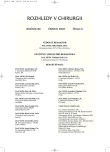Brachial Artery Pseudoaneurysm – Infrequent Complication Secondary to Parenteral Drug Abuse
Authors:
E. Biroš 1; M. Maresch 2; I. Rathous 1; J. Šváb 1
Authors‘ workplace:
I. chirurgická klinika VFN a 1. LF UK, přednosta doc. MUDr. J. Šváb, CSc.
1; II. chirurgická klinika VFN a 1. LF UK, přednosta doc. MUDr. J. Tošovský, CSc.
2
Published in:
Rozhl. Chir., 2007, roč. 86, č. 6, s. 309-311.
Category:
Monothematic special - Original
Overview
Introduction:
Intravenous drug abuse brings many infectious and surgical complications. Considering the duration of a drug scene in Czech Republic, pseudoaneurysms are not frequent complications, but we can expect their increased frequency with time.
Methods:
A 27-year-old patient with known history of parenteral drug abuse (heroin, pervitin) was treated at our department during the autumn of 2006. He had self-injected heroin into an armpit four days before his appearance in our outpatient department. An abscess of his left arm and armpit resulting from cellulitis was his admission diagnosis based on a clinical ground. We did not validate that diagnosis with any radiology test. The operation made clear that pseudoaneurysm in a proximal part of brachial artery was a correct diagnosis. Because of severe inflammation of his left upper extremity, the pseudoaneurysm was dealt with resection, ligation of the brachial artery above and below the defect and leaving the incision to heal by secondary intention.
Results and conclusions:
The pseudoaneurysm was treated with excision, tying the proximal and distal ends of brachial artery without urgent revascularization, extensive debridement of all necrotic tissues and leaving the incision to heal by secondary intention. Our approach did not threaten viability of the limb, which did not show any signs of ischemia during close postoperative monitoring. Our way seems to be appropriate and in agreement with current literature. The peroperative finding stresses the necessity of standard and Doppler ultrasound in every intravenous drug abuser with clinical picture of „a typical abscess” located in groin, elbow and armpit.
Key words:
pseudoaneurysm – brachial artery – intravenous drug abuse – Doppler ultrasound
Sources
1. Miovský, M., Miovská, L., Mravčík, V. Aktuální přehled stavu užívání nelegálních drog v České republice. Čas. Lék. čes., 2004, roč. 143, č. 11, s. 723–730. ISSN: 0008-7335
2. Ebright, J. R., Pieper, B. Skin and soft tissue infections in injection drug users. Infectious Disease Clinics of North America, 2002, 16, s. 697–712.
3. Binswanger, I. A., Kral, A. H., Bluthenthal, R. N., et al. High prevalence of abscesses and cellulitis among community-recruited injection drug users in San Francisco. Clin. Infect Dis., 2000, 30, s. 579–581.
4. Laca, Ľ., Petrašovič, M., Danninger, F., Olejník, J. Rozsiahly defekt inguinálnej oblasti s poškodením stehenných ciev. Rekonštrukcia arteriálneho zásobenia a kožného krytu v jednej dobe. Rozhl. Chir., 2000, roč. 79, č. 10, s. 471–473.
5. Wing, T. S., Kwok, K. Y., Hester, Y. S. Ch. Management of brachial artery pseudoaneurysms secondary to drug abuse. Ann. Vasc. Surg., 2005, roč. 19, s. 657–661.
6. Coughlln, P. A., Mavor, A. I. D. Review: Arterial consequences of recreational drug use. Eur. J. Vasc. Endovasc. Surg., 2006, roč. 32, s. 389–396.
7. Naql, S. A., Khan, H. M., Akhtar, S., Shah, T. A. Femoral pseudoaneurysm in drug addicts – excision without revascularization is a viable option. Eur. J. Vasc. Endovasc. Surg., 2006, roč. 31, s. 585–587.
8. Behera, A., Menakuru, S. R., Jindal, R. Vascular complications of drug abuse: an Indian experience. ANZ J. Surg., 2003 Dec; 73(12), s. 1004–1007.
9. Ting, A. C., Cheng, S. W. Femoral pseudoaneurysms in drug addicts. World J. Surg., 1997 Oct; 21(8), s. 783–786.
10. Gan, J. P., Leiberman, D. P., Pollock, J. G. Outcome after ligation of infected false femoral aneurysms in intravenous drug abusers. Eur. J. Vasc. Endovasc. Surg., 2000 Feb, 19(2), s. 158–161.
11. Lagattolla, N. R., Baghai, M., Biswas, S., Redinton, A. E., et al. Tuberculous false aneurysm of the femoral artery managed by endoluminal stent graft insertion. Eur. J. Vasc. Endovasc. Surg., 2000, roč. 19, s. 440–442.
12. Goel, P. K., Modi, N., Baijal, S. S., Kathuria, M., Agrawal, S. K. Sonographically guided thrombin injection for the treatment of femoral artery pseudoaneurysm. Indian Heart J., 2003, 55(4), s. 365–367.
13. Ferrer-Puchol, M. D., Esteban, J. E., Gil, J., Guijarro, J. Sonographic diagnosis of a pseudoaneurysm in an intravenous drug abuser. J. Clin. Ultrasound., 2000 Feb; 28(2), s. 104–107.
14. Chan, Y. C., Burnand, K. G. Management of septic groin complication and infected femoral false aneurysms in intravenous drug abusers. British Journal of Surgery, 2006, 93, s. 781–782.
15. Salehian, M. T., Shahid, N., Mohseni, M., Ghodoosi, I., Marashi, S. A., Fazel, I. Treatment of infected pseudoaneurysm in drug abusers: Ligation or reconstruction? Archives of Iranian Medicine, 2006; 9(1), s. 49–52.
16. Petrovický, P., et al. Anatomie s topografií a klinickými aplikacemi. II. svazek. Martin: vydavetelství Osveta, 2001. 560 s. ISBN 80-8063-046-1.
Labels
Surgery Orthopaedics Trauma surgeryArticle was published in
Perspectives in Surgery

2007 Issue 6
Most read in this issue
- Laparoscopic Management of Epidermoid Spleen Cyst
- Complications of the Laparoscopic Appendectomy
- Pyogenic Abscesses of the Liver
- Disorder of Vertebral Metastasis
